Spelter (or zinc)
Download PDFFor a long time, the French art market has called "spelter" (French : "Régule") a light and molded metal which is in fact zinc. Moreover, the technical manuals of the time use "zinc sculpture" (French : "zinc d'art") for sculpture copies and works of art made especially from the second half of the 19th century. The term "spelter" is never used in France during the 19th century.
The real spelter is an alloy appeared at the end of the 19th century. It is made up of antimony, lead and sometimes tin. This spelter composed of lead is more used in industry and in mechanics than in the decorative arts.
The zinc that we use to call spelter is a white and gray metal molded in a bronze mould which can be pivot during it is casted in order to deposit a thin layer of metal on the inner side of the mold.
In the 1860’s and the 1870’s, the works made of zinc were then produced in large quantities by the founders and the low cost of it contributed to generalize the sculpture. Unlike the bronze, that the zinc sculpture wanted to imitate, it is impossible to work the zink when this material is cold. Therefore, we can not chisel or carve it: the mold must be as precise as possible especially concerning the fineness of the details.
The zinc sculpture and the lead spelter can be covered with copper by electroplating then gilded, but they are more generally patinated: it means that they are painted with copper, silver or polychrome pigments (more precisely, it is a glazing with turpentine and pigments). Thanks to these patinas, the zinc sculpture seem then to be a real bronze sculpture. So it is important to know how to distinguish them.
First of all zinc and spelter are lighter and more fragile than bronze, and consequently they can have easily visible cracks. In this case, it is very simple to distinguish the color of the original metal, without patina, which, in the case of the spelter, will be white and gray while the bronze would have been yellow. Finally, the spelter sound and the bronze sound make it possible to differentiate them: the spelter will have a deep resonance whereas the bronze will make a rather acute sound.
In 1910, faced with numerous confusions, the bronze makers obtained a court ruling which obligated the manufacturers of zinc sculpture to put the mention "bronze imitation" instead of "bronze art", particularly because of the realization of the same models both made up of bronze and zinc or spelter. Some editions of the famous sculptures by the brothers Hippolyte and Auguste Moreau were thus both in bronze and spelter.
Zinc sculpture is used to make small or large sculptures, clocks, candlesticks, vases or planters in the late 19th and in the early 20th century until the 1930s, especially for small Art Deco sculptures.








